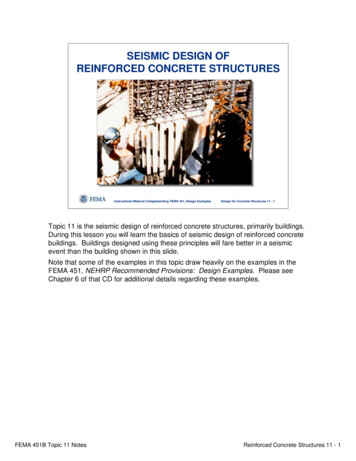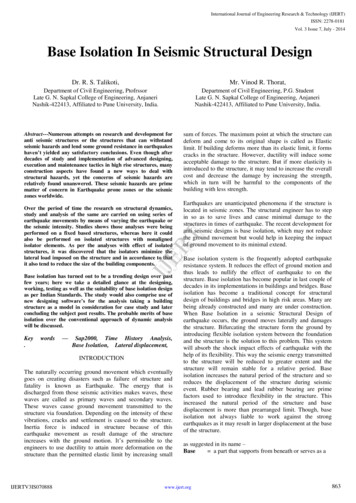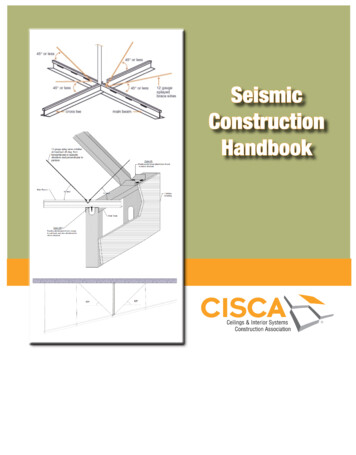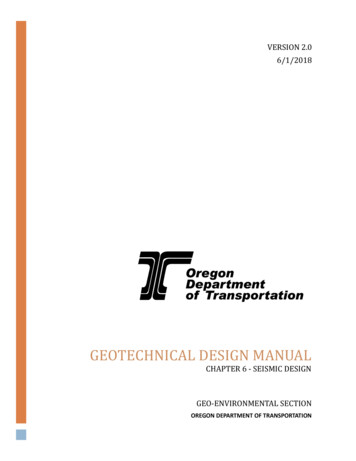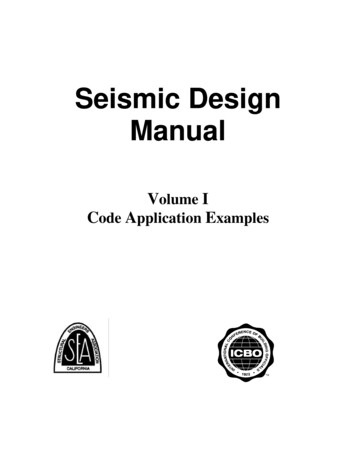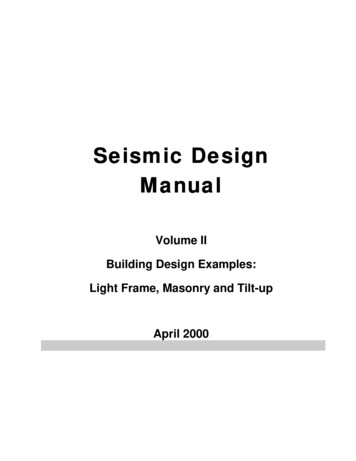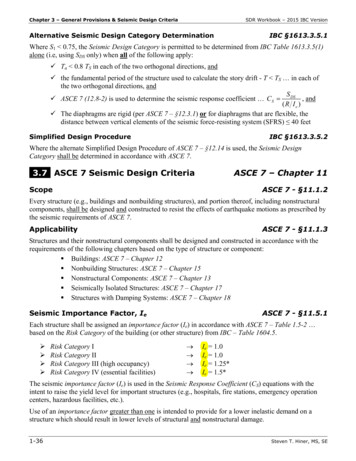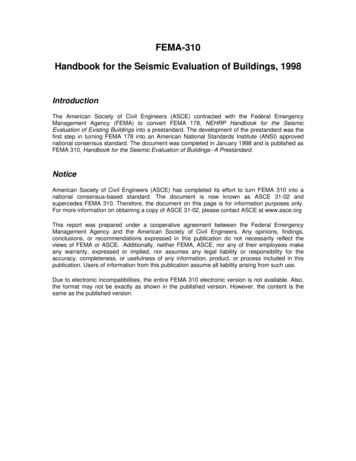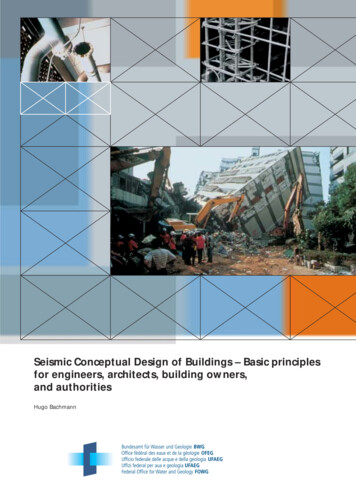
Transcription
Seismic Conceptual Design of Buildings – Basic principlesfor engineers, architects, building owners,and authoritiesHugo Bachmann
Federal Department of Foreign Affairs (DFA)Federal Department of the Environment, Transport, Energy and Communications (DETEC)Seismic Conceptual Design of Buildings – Basic principlesfor engineers, architects, building owners,and authoritiesHugo Bachmann
ImpressumEditor:Swiss Federal Office for Water and GeologySwiss Agency for Development and CooperationQuoting:Hugo Bachmann: Seismic Conceptual Design ofBuildings – Basic principles for engineers, architects,building owners, and authorities (Biel 2002, 81p.)Available in french and german.This publication is downloadable on the internet asa pdf file at www.bwg.admin.chDesign:Brotbeck Corporate Design, BielImpression:3’000eOrder Number: 804.802 eAdress:BBL, Vertrieb Publikationen, CH-3003 Bern,Internet: www.bbl.admin.ch/bundespublikationenCopyright: BWG, Biel, 2003
Author’s PrefaceFor a long time earthquake risk was consideredunavoidable. It was accepted that buildings would bedamaged as a result of an earthquake’s ground shaking. Preventive measures for earthquakes were therefore mostly limited to disaster management preparedness. Although measures related to constructionmethods had already been proposed at the beginningof the 20th century, it is only during the last decadesthat improved and intensified research has revealedhow to effectively reduce the vulnerability of structuresto earthquakes.The objective of this document is to present recentknowledge on earthquake protection measures forbuildings in a simple and easy to understand manner.Editor’s PrefaceWorldwide earthquakes cause regularly large economiclosses - Kobe in 1995 with more than 6000 causalities,counted for 100 Billion US of economic loss. Earthquakes are unavoidable. Reducing disaster risk is a toppriority not only for engineers and disaster managers,but also for development planners and policy-makersaround the world. Disaster and risk reduction are anessential part of sustainable development.On December 11 2000, the Swiss Federal Councilapproved for federal buildings a seven-point programrunning from 2001 to 2004 for earthquake damageprevention. The earthquake resistance of newstructures is a high priority in the Confederation’sseven-point program. The author of this publication,Professor Hugo Bachmann, has devoted many years tothe study of seismic risk and behavior of buildingssubjected to earthquakes. At the request of theFOWG, which expresses its gratitude to him, he agreedto make available his extensive scientific knowledge onearthquake resistance of buildings. These guidelinesare designed to contribute to the transfer of researchresults into building practice. These results must beThe chosen method explains basic principles by matching them with illustrations, examples, and an explanatory text. The principles, photographs (from the authoror third parties), and the texts are the result of a longresearch and design activity in the challenging andstrongly evolving field of earthquake engineering.The author would like to thank, above all, the numerous photographs contributors mentioned at the end ofthe booklet, who have made available the results ofextensive and often dangerous efforts. Thanks are alsoextended to the Federal Office for Water and Geologyand the Swiss Agency for Development and Cooperation for editing and carefully printing this document.Zurich, December 2002Prof. Hugo Bachmanntaken into account by the design professionals, thusensuring a reasonable earthquake resistance for newstructures at little or no additional cost.SDC would like to contribute to the dissemination ofknowledge on seismic design of buildings by translating this FWOG publication in English and thus extending its readership among construction professionals.SDC intends to gather available experience in thedomains of construction and prevention of naturalhazards and technical risks and to make it accessible tothe practitioners in developing and transition countriesin an easy to understand form.Biel, December 2002Dr Christian FurrerDirector of the Federal Officefor Water and Geology (FOWG)Bern, December 2002Ambassador Walter FuestDirector of the Swiss Agencyfor Development and Cooperation (SDC)Basic principles for engineers, architects, building owners, and authorities3
Table of ContentsObjectives6What happens during an earthquake?7The most important natural risk8The seismic risk keeps increasing9Insufficient measures9Urgent action is needed9BP 1The architect and the engineer collaborate from the outset!10BP 2Follow the seismic provisions of the building codes!11BP 3No significant additional cost thanks to modern methods!13BP 4Avoid soft-storey ground floors!15BP 5Avoid soft-storey upper floors!19BP 6Avoid asymmetric bracing!21BP 7Avoid bracing offsets!24BP 8Discontinuities in stiffness and resistance cause problems!25BP 9Two slender reinforced concrete structural walls in eachprincipal direction!26BP 10 Avoid mixed systems with columns and structural masonry walls!28BP 11 Avoid «bracing» of frames with masonry infills!29BP 12 Brace masonry buildings with reinforced concrete structural walls!32BP 13 Reinforce structural masonry walls to resist horizontal actions!34BP 14 Match structural and non-structural elements!38BP 15 In skeleton structures, separate non-structural masonry walls by joints! 40BP 16 Avoid short columns!42BP 17 Avoid partially infilled frames!44Basic principles for engineers, architects, building owners, and authorities4
BP 18 Design diagonal steel bracing carefully!46BP 19 Design steel structures to be ductile!48BP 20 Separate adjacent buildings by joints!50BP 21 Favour compact plan configurations!52BP 22 Use the slabs to «tie in» the elements and distribute the forces!53BP 23 Ductile structures through capacity design!55BP 24 Use ductile reinforcing steel with: Rm/Re 1.15 and Agt 6 %!56BP 25 Use transverse reinforcement with 135 hooks and spacedat s 5d in structural walls and columns!58BP 26 No openings or recesses in plastic zones!60BP 27 Secure connections in prefabricated buildings!62BP 28 Protect foundations through capacity design!64BP 29 Develop a site specific response spectrum!65BP 30 Assess the potential for soil liquefaction!66BP 31 Softening may be more beneficial than strengthening!68BP 32 Anchor facade elements against horizontal forces!70BP 33 Anchor free standing parapets and walls!72BP 34 Fasten suspended ceilings and light fittings!74BP 35 Fasten installations and equipment!75Illustration credits78Bibliography79Contacts / Links80Appendix: Global Seismic Hazard MAP81Basic principles for engineers, architects, building owners, and authorities5
ObjectivesThis document offers a broad outline of the art ofdesigning earthquake resistant buildings. It describesbasic principles guiding the seismic design ofstructures. These principles govern primarily the: Conceptual design, and the Detailingof Structural elements and Non-structural elementsThe conceptual design and the detailing of the structuralelements (walls, columns, slabs) and the non-structuralelements (partition walls, façades) plays a central role indetermining the structural behaviour (before failure) andthe earthquake vulnerability (sensitivity to damage) ofbuildings. Errors and defects in the conceptual designcannot be compensated for in the following calculationsand detailed design of the engineer. A seismicallycorrect conceptual design is furthermore necessary inorder to achieve a good earthquake resistance withoutincurring significant additional costs.The outlined principles are thus primarily applicableto new buildings. However, it is quite clearthat they may also be used for the evaluation andpossible upgrading of existing buildings. Therefore,certain principles are illustrated with applications toexisting buildings.The basic principles (BP) are grouped according to thefollowing subjects: collaboration, building codes and costs (BP 1 to BP 3) lateral bracing and deformations (BP 4 to BP 20) conceptual design in plan (BP 21 to BP 22) detailing of structural elements (BP 23 to BP 27) foundations and soil (BP 28 to BP 31) non-structural elements and installations(BP 32 to BP 35)It is obvious that not all the basic principles are of thesame importance, neither in a general context nor inrelation to a particular object. Compromises, based onengineering judgement, may be admissible dependingon the hazard level (regional hazard and site effect) andthe characteristics of the structure. Of primary importance is the strict adherence to the principles relevant tolife safety, particularly those concerning lateral bracing.Only principles primarily intended to reduce materialdamage may possibly be the subject of concessions.This document is predominantly addressed to construction professionals such as civil engineers and architects,but also to building owners and authorities. It is suitableboth for self-study and as a basis for university coursesand continued education. The illustrations may beobtained from the editor in electronic format. All otherrights, in particular related to the reproduction ofillustrations and text, are reserved.The basic principles are intentionally simple. Calculationsand detailed design are only marginally introduced.Additional information may be found in specialisedliterature (eg. [Ba02]).The ideas and concepts of the basic principles weredeveloped within a framework consisting of numerouspresentations given by the author between 1997 and2000, the contents of which were constantly elaboratedand developed. Each principle is introduced by aschematic figure (synthesis of the principle), followed bya general description. Further illustration is usuallyprovided by photographs of damage, giving eitherpositive or negative examples, and accompanied by aspecific legend.Basic principles for engineers, architects, building owners, and authorities6
What happens during an earthquake?What happens during an earthquake?Time history of ground motion parametersE/1E/2Rapid ground-motion:How long?How much?Structural (Building) response:– Strong vibrations– Large stresses and strains– Local failure– Total failure CollapseTime (s)Prof. Hugo Bachmannibk – ETH ZurichIn an earthquake, seismic waves arise from suddenmovements in a rupture zone (active fault) in theearth's crust. Waves of different types and velocitiestravel different paths before reaching a building’s siteand subjecting the local ground to various motions.The ground moves rapidly back and forth in alldirections, usually mainly horizontally, but also vertically. What is the duration of the ground motions?For example, an earthquake of average intensity lastsapproximately 10–20 seconds, a relatively short duration. What is the maximum amplitude of the motions?For example, for a typical «Valais Quake» of anapproximate magnitude of 6 (similar to the earthquakethat caused damage in the Visp region in 1855), theamplitudes in the various directions of the horizontalplane can reach about 8, 10, or even 12 cm. During anearthquake of magnitude 6.5 or more (similar to the«Basel Quake» that destroyed most of the city of Baseland its surroundings in 1356), ground displacementscan reach 15-20 cm, and perhaps somewhat more.What happens to the buildings? If the ground movesrapidly back and forth, then the foundations of thebuilding are forced to follow these movements. Theupper part of the building however «would prefer» toremain where it is because of its mass of inertia. Thiscauses strong vibrations of the structure withresonance phenomena between the structure and theground, and thus large internal forces. This frequentlyresults in plastic deformation of the structure andsubstantial damage with local failures and, in extremecases, collapse.Prof. Hugo Bachmannibk – ETH ZurichThe effects of an earthquake on a building are primarily determined by the time histories of the three groundmotion parameters; ground acceleration (ag), velocity(vg), and displacement (dg), with their specificfrequency contents. Looking at the example of thelinear horizontal ground motion chart of an artificiallygenerated «Valais Quake», it is clear that the dominantfrequencies of acceleration are substantially higherthan those for velocity and much higher than those fordisplacement.The ground motion parameters and other characteristic values at a location due to an earthquake of a givenmagnitude may vary strongly. They depend onnumerous factors, such as the distance, direction,depth, and mechanism of the fault zone in the earth'scrust (epicentre), as well as, in particular, the local soilcharacteristics (layer thickness, shear wave velocity).In comparison with rock, softer soils are particularlyprone to substantial local amplification of the seismicwaves. As for the response of a building to the groundmotion, it depends on important structural characteristics (eigenfrequency, type of structure, ductility,etc).Buildings must therefore be designed to coverconsiderable uncertainties and variations.Basic principles for engineers, architects, building owners, and authorities7
The most important natural riskEarthquakes of large magnitudes can often be classified as great natural catastrophes. That is to say thatthe ability of a region to help itself after such an eventis distinctly overtaxed, making interregional orinternational assistance necessary. This is usually thecase when thousands of people are killed, hundreds ofthousands are made homeless, or when a countrysuffers substantial economic losses, depending on theeconomic circumstances generally prevailing in thatcountry.The 2001 Gujarat earthquake is a recent example ofsuch a catastrophe. It was the first major earthquaketo hit an urban area of India in the last 50 years. Itkilled 13'800 people and injured some 167'000. Over230'000 one- and two-story masonry houses collapsedand 980'000 more were damaged. Further, manylifelines were destroyed or severely damaged and defacto non-functional over a long period of time. Thenet direct and indirect economic loss due to the damage and destruction is estimated to be about US 5billion. The human deaths, destruction of houses anddirect and indirect economic losses caused a majorsetback in the developmental process of the State ofGujarat.From 1950 to 1999, 234 natural catastrophes werecategorized as great natural catastrophes [MR 00].From these 234, 68 (29%) were earthquakes. Themost important ones in terms of loss of lives were the1976 Tangshan earthquake (China), with 290'000fatalities and the 1970 Chimbote earthquake (Peru),with 67'000 fatalities. In terms of economic losses, theGreat natural catastrophes 1950-1999E/3Fatalities: 1.4 mio1%Economic losses: US 960 nich Re Group, 2000Basic principles for engineers, architects, building owners, and authorities8Others
most important ones were the 1995 Kobe earthquake(Japan), with US 100 billion, and the 1994 Northridgeearthquake (USA) with US 44 billion.In terms of loss of lives and economic losses, it can beseen on the figure of page 8 that earthquakesrepresent the most important risk from natural hazardsworldwide. It is tempting to think that this risk isconcentrated only in areas of high seismicity, but thisreasoning does not hold. In regions of low to moderate seismicity earthquakes can be a predominant riskas well. There, hazard can be seen as relatively low, butvulnerability is very high because of the lack of preventive measures. This combined leads to a high risk.The seismic risk keeps increasingThe seismic risk is equal to the product of the hazard(intensity/probability of occurrence of the event, localsoil characteristics), the exposed value and the vulnerability of the building stock. The current building stockis constantly enlarged by the addition of newbuildings, many with significant, or even excessive,earthquake vulnerability. This is above all due to thefact that for new buildings, the basic principles ofearthquake resistant design and also the earthquakespecifications of the building codes, are often notfollowed. The reason is either unawareness, convenience or intentional ignorance. As a result, theearthquake risk continues to increase unnecessarily.Devastating induced hazardsApart from structural hazards due to ground shaking,extensive loss can be caused by the so-called inducedhazards such as landslides, liquefaction, fire, retainingstructure failures, critical lifeline failures, tsunamis andseiches.For example, the 2001 San Salvador earthquakeinduced 16'000 landslides causing damage to 200'000houses. In the 1970 Chimbote earthquake (Peru), agigantic landslide triggered by the earthquake caused25’000 fatalities, more than a third of the totalfatalitites. In the 1906 San Francisco earthquake, mostof the damage was caused by uncontrolled fire. In the1995 Kobe earthquake fire was responsible for 8% ofthe destroyed houses.Urgent action is neededThe preceding remarks clearly illustrate that there is alarge deficit in the structural measures for seismicprotection in many parts of the world. There is anenormous pent up demand and accordingly a need forurgent action. New buildings must be designed to bereasonably earthquake resistant to prevent theconstant addition of new vulnerable structures to abuilding stock that is already seriously threatened. Tothis end, the present publication aims at contributingby spreading the appropriate basic knowledge.Basic principles for engineers, architects, building owners, and authorities9
BP 1 The architect and the engineer collaboratefrom the outset!Basic principles for the seismic design of buildings1Building ownerArchitectBasic principles for the seismic design of buildings1. Architect: Conceptual designof structure and non-structuralelementsCivil Engineer1/2Wrong:«Serial-design»1. Structure for gravity loads2. Non-structural elements3. Structure for seismic action2. Engineer: Calculations Much better and more economical:The architect and engineer collaboratefrom the outset!«Parallell-design» The architect and engineercollaborateProf. Hugo Bachmannibk – ETH ZurichMany building owners and architects are still of themistaken opinion that it is sufficient to include the civilengineer only at the end of the design stage to «calculate» the structure. This is a bad approach that mayhave serious consequences and cause significant additional costs. Even the cleverest calculations and detaileddesign cannot compensate for errors and defects inthe conceptual seismic design of the structure or in theselection of non-structural elements, in particularpartition walls and facade elements.Basic principles for the seismic design of buildings1/1Even the cleverest calculations and detailed design cannotcompensate for errors and defects in the conceptualseismic design of the structural and non-structural elements!Close collaboration between architect andcivil engineer from the earliest planning stage!Prof. Hugo Bachmannibk – ETH ZurichIt is important that there is a close collaboration betweenthe architect and the engineer from the earliest planningstage of any building project in order to ensure a goodoutcome, guarantee structural safety, reduce vulnerability,and limit costs. By doing so, both partners contribute withdifferent, yet indispensable, expertise. The architect dealsprimarily with the aesthetic and functional design, whileProf. Hugo Bachmannibk – ETH Zurichthe engineer produces a safe, efficient and economicalstructure. This is why collaboration between the architectand the engineer must start at the first design draft!«Serial-design» is particularly bad and inefficient. It isnot at all efficient that the architect performs theconceptual design and selects the types and materials ofthe non-structural partition walls and façade elementsbefore entrusting the engineer with the calculations anddetailed design of the structure. It is also wrong toconsider seismic loading only after completing thegravity load design and selecting the non-structuralelements. By then the structure can only be «fixed» forearthquakes. This will often result in an expensive andunsatisfactory patchwork.A «parallell-design» is much better and usually substantially more economical. The architect and the engineerdesign together and, taking into account the relevantaesthetic and functional requirements, develop a safe,efficient, and economical «general-purpose» structurefor gravity loads and seismic action. They then togetherselect non-structural partition walls and facade elementswith deformation capacities compatible with thedesigned structure. An optimum result can be obtainedthrough this approach. A close and thoughtfulcollaboration between the architect and the engineeris therefore also of interest to the building owner.This collaboration cannot wait for the calculation anddetailed design stage, but must start at the earliestconceptual design stage when choices are made thatare crucial for the seismic resistance and vulnerability ofthe building.Basic principles for engineers, architects, building owners, and authorities10 General purpose structureand non-structural elements
BP 2 Follow the seismic provisions of the codes!Basic principles for the seismic design of buildings2Internationally harmonized standards:ISO 3010International Building Code (IBC)Uniform Building Code (UBC)Eurocode 8National standards:SIA 261 (Switzerland)IS 1893 (India)DIN 4149 (Germany)PS 92 (France) .Follow the seismic provisions of the codes!T. WenkIn the early 20th century, the first seismic provisionsin building codes were introduced in a few countrieswith high seismicity. These early seismic codes havebeen periodically updated with increasing knowledgein earthquake engineering. In the 1960's and 1970's,countries with moderate seismicity began to adoptseismic requirements in their building codes.In the same period, the better understanding ofdynamic soil behavior as well as inelastic structuralbehavior led to the development of more advancedseismic codes.The ignorance or disregard of the seismic provisions ofthe building codes, even if only partial, can result in aninferior building [Sc 00]. The reduction in value mayinclude, among other things, the costs of retrofittingminus the additional costs that would have beenincurred to ensure the seismic resistance of the building at its design and construction stage. The designerscan be responsible for retrofitting costs, as well asjointly liable with the building owners for loss of life ,injury or for any resulting material damage in the caseof an earthquake. A retrofit generally costs severaltimes more than what it would have cost to ensureadequate seismic resistance of the new building.Considerable costs may also be incurred by disruptionsof the building’s use, such as temporary evacuationand business interruption. Furthermore, determiningthe responsibility of the architect and engineer cannecessitate lengthy and complex legal procedures.The building owner, the architect, the engineer, andthe authorities therefore have a vested interest inensuring that the seismic provisions of the buildingcodes are strictly enforced, and that appropriatestructural calculations and verifications are kept withthe construction documents.Today, the principles of capacity design together withthe concepts of ductile behavior allow a safe andcost effective earthquake resistant design. The latestefforts of seismic code development were mainlyfocused on internationally harmonized standards likeISO 3010, Eurocode 8, and UBC.Unfortunately, even today, the seismic provisions of thebuilding codes are not always respected; this is due toeither ignorance, indifference, convenience, ornegligence. Moreover, appropriate official controls andchecks are lacking. Buildings that are very vulnerableand at risk from even a relatively weak earthquakecontinue to be built today. Investigations of existingbuildings (e.g. [La 02]) showed however, that enforcingthe building code requirements makes it possible tosignificantly reduce the seismic vulnerability ofbuildings with no significant additional costs whileimproving their resistance against collapse.Basic principles for engineers, architects, building owners, and authorities11
2/1 Buildings are still built for which no verification of adequateseismic resistance is conducted in accordance with the current building codes. In the case of this masonry building, it appears that noadequate measures (e.g. reinforced structural concrete walls) weretaken. An insufficient earthquake resistance may cause a significantreduction in the value of the building, and may be the cause of a civilliability lawsuit (Switzerland, 2001).2/2 Buildings in which the lateral bracing is missing or highly eccentric,or buildings with discontinuities, generally do not satisfy therequirements of the current building codes and are therefore likely tobe damaged or collapse under the effect of even a relatively weakearthquake (Switzerland 2000).Basic principles for engineers, architects, building owners, and authorities12
BP 3 No significant additional costs thanksto modern methods!Basic principles for the seismic design of buildings3The costs of earthquake resistance depends on:planning approachapplied method No significant additional costs thanksto modern methods!Prof. Hugo Bachmannibk – ETH ZurichThe opinion that designing new buildings to be earthquake resistant will cause substantial additionnal costsis still common among the construction professionnals.In a swiss survey, estimates between 3 and 17% of thetotal building costs were given. This opinion isunfounded. In a country of moderate seismicity,adequate seismic resistance of new buildings may beachieved at no, or no significant, additional cost.However, the expenditure needed to ensure adequateseismic resistance may depend strongly on theapproach selected during the conceptual design phaseand on the relevant design method: Regarding the conceptual design phase, early collaboration between the architect and civil engineeris crucial (see BP 1). Seismic protection must betaken into consideration in the architectural designof the building as well as in the conceptual designof the structure. Above all, substantial extra costsmay be incurred if modifications and additions tothe structure need to be made at an advancedstage, since they often require modifications of thearchitectural design also. These may be very costly. Concerning the design method, it should be statedthat significant progress has been made recently.Intensive research has improved the understandingof the behaviour of a building or structure duringan earthquake and resulted in the developmentof more efficient and modern design methods.Compared to older methods, the cost of seismicresistance of a building is reduced and / orthe performance during an earthquake is notablyimproved, thus also reducing vulnerability. Of specialimportance are ductile structures and the associateddesign method named capacity design method.Thus, structural elements such as reinforcedconcrete walls, which are used for wind bracing,can perform other functions without notable additional cost (e.g. by modifying the reinforcement).Fewer additional structural elements are thereforerequired in comparison to older methods.Information on the application and advantages ofmodern methods can be found in the publication[D0171]. This document describes the seismic designof a seven storey residential and commercial building.It enables a comparison between the deformationoriented capacity design and conventional design(earlier method). The advantages of the modernmethod for this example can be summarised as follows(see also page 14):– drastic reduction in the seismic design forces atultimate limit state;– better resistance against collapse;– good deformation control;– prevention of damage for earthquakes up to achosen intensity (damage limit state earthquake);– larger flexibility in case of changes in building use;– practically equal costs.The last three advantages are particularly important tothe building owner. The larger flexibility with respectto the changes in building use results primarily fromthe fact that the majority of the walls can be modifiedor even removed without any problem.Page 143/1 Results of the seismic design of a seven storey residential andcommercial building by different methods [D0171].Basic principles for engineers, architects, building owners, and authorities13
Seismic conventional designWest façadeCSection CSection HSection CSection KH4. floor3. floor2. floor1. floormezzaninneground floor1. basement2. basementCHSeismic conceptual design andcapacity designWest façadeCK4. floor3. floor2. floor1. floormezzaninneground floor1. basement2. basementCKWalls, slabs, main beams and columns in reinforced concrete to resist gravity loadsReinforced concrete walls and frames to resist earthquake actionsStructural masonryBasic principles for engineers, architects, building owners, and authorities14
BP 4 Avoid soft-storey ground floors!Basic principles for the seismic design of buildings4Avoid soft-storey ground floors!Prof. Hugo Bachmannibk – ETH ZurichMany building collapses during earthquakes may beattributed to the fact that the bracing elements, e.g.walls, which are available in the upper floors, areomitted in the ground floor and substituted bycolumns. Thus a ground floor that is soft in thehorizontal direction is developed (soft storey). Oftenthe columns are damaged by the cyclic displacementsbetween the moving soil and the upper part of thebuilding. The plastic deformations (plastic hinges) atthe top and bottom end of the columns lead to adangerous sway mechanism (storey mechanism) with alarge concentration of the plastic deformations at thecolumn ends.A collapse is often inevitable.4/2 Sway
5 Basic principles for engineers, architects, building owners, and authorities BP 18 Design diagonal steel bracing carefully! 46 BP 19 Design steel structures to be ductile! 48 BP 20 Separate adjacent buildings by joints! 50 BP 21 Favour compact plan configurations! 52 BP 22 Use the slabs to «tie in» the elements and distribute t
